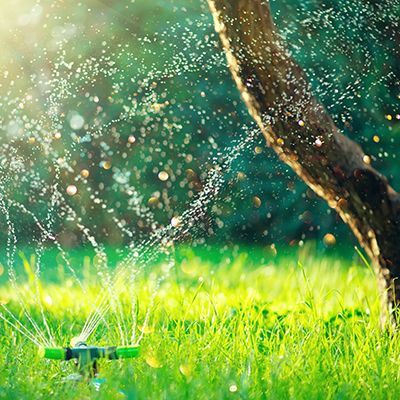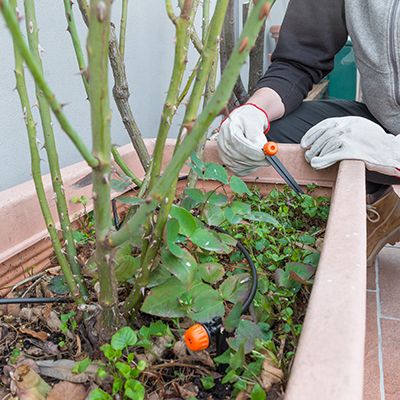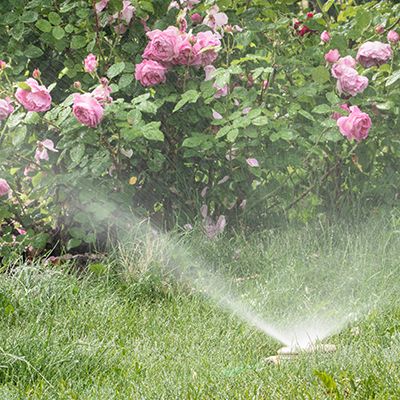


Conserving Garden Water for Trees, Shrubs and Roses
With very little rain this winter; the water reserves in our soil is almost depleted. Gardeners in past years relied on soil moisture and did not have to irrigate trees and shrubs until June. Not so this year and many of our plants are showing stress. Common symptoms of drought stressed trees and shrubs are curled leaves, yellow or brown leaves, jagged, torn leaf margins and the leaves or fruits which drop prematurely. Lace leaf varieties such as Acer dissectum are particularly vulnerable. All these trees and shrubs will die unless they receive extra care.
When you have valuable and important trees on your property, they will require that extra care to avoid losing them. A ten-year-old Japanese Maple or a Crab Apple will be difficult and expensive to replace if it should die.
Trees and Shrubs
Among the steps that can be taken to help your trees and shrubs survive are the following:
- Sacrifice the lawn. Turn off the sprinklers and use the lawn water for the trees,
- If new landscaping is installed, never plant trees or shrubs in the lawn. (Trees & turf don’t mix.)
- Set sprinklers on a coarse spray (less evaporation) to come on at night. Do not water hardscape or house. Check with your local municipality for water-saving benefits such as Redwood City who will give 25 free efficient sprinkler nozzles to homeowners.
- Apply all of the recommended water saving suggestions in the home. Use the saved water for the trees check for leaks in toilets and faucets, don’t leave water running while washing or brushing, install flow restrictors, insulate pipes and replace old toilets washing machines and dishwashers.
- Drill 1-1/2" to 2" holes at the drip line of the tree(s), about 12-16" deep and two feet apart. Fill with perlite. Next circle the tree with soaker hose at the dripline and half way between the dripline and the trunk. Turn on the soaker hose so it barely oozes out water and run until the soil is moist 16" deep. (this may take 3-6 hours) Cover the entire tree area from almost the trunk (Leave 3" space) all the way to the dripline with mulch. Check for moisture after 2-3 weeks and repeat soaker hose process if top 3-4" of soil is dry,
- Citrus will require extra care. Construct a soil berm 4”-6” high at the dripline of the tree and flood the area once a month if the tree is well established or every week or two is it is new tree.
- Clear all plant material from the area between a tree’s trunk to two feet beyond the drip line. Mulch the area 2”-4” deep but not within 3” of the tree’s trunk. Irrigate with bubblers at the drip line, 2 feet apart.
- Summer-prune all deciduous trees. Remove 1/3 to 1/2 of all new growth to reduce the tree’s water evaporation and consequent consumption.
- Spray small trees with an anti-transpirant such as Cloud Cover to reduce water evaporation.
- Catch rinse water and run-off soapy water in a pail in the shower. Pour the water on trees or shrubs or use it to flush the toilet. Connect a garden hose to the discharge hose of the washing machine and let it empty near a tree, rose bed or a flower bed to provide extra irrigation. Detergent water is OK.
- Irrigate border hedges and landscape shrubs at house foundations with soaker hoses set at lowest pressure possible and run for 4-5 hours every two weeks. Mulch over the hose.
Roses
Many of the treatments described for Trees and Shrubs will apply to the Rose garden. Do not expect your Roses to flower and grow as they would under more normal conditions.
Set low angle sprinklers or drippers to irrigate a 4 to 6 foot diameter area for each Rose bush. Water Roses for 1/2 hour; once a week; at dawn. Apply 1/4 the normal amount of fertilizer on July 4 and Labor Day or give no fertilizer at all. Be sure to water it in.
Do not plant anything between or around the rose bushes. If you have a rose bush of questionable value, get rid of it. Mulch 2" to 4" deep over the entire rose bed.
Prune away 1/3 of each Rose bush to reduce evaporation from the leaves and decrease water absorption by the roots.
Root prune each bush at its drip line using a sharp spade.
If you have one floribunda to remind yourself of how Roses should be, plant it in a 15 gallon container with top grade potting soil such as Master Nursery Garden’s Gold. Our selection was “French Lace”(see Photo). We have a saucer under the pot to hold 1” of water and we irrigate twice or three times a week. The container is fertilized monthly with Master Nursery Rose and Flower Food. “French Lace” blooms almost continuously and we look forward to better times.
Numerous rebate offers are available to encourage water conservation:
- Rebate up to $1000 for removing lawn and replacing with low water use plants.
- Up to $200 rebate to replace old clothes washer with a High Efficiency washer.
- Up to $100 for replacing an old toilet with a high efficiency toilet.
- Free water efficient sprinkler nozzles.
For more information and house calls:
Redwood City area: Water Resources Management Program
650-780-7436
redwoodcity.org/conservation
Santa Clara Valley Water District
Water Wise House Call Program at (408) 265-2600 ext.2554 or (888) 439-6624
valleywater.org
If and when the droughts ends, keep these tips in mind and have them become part of your normal gardening practices. Water conservation should become part of our everyday gardening.